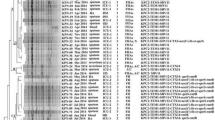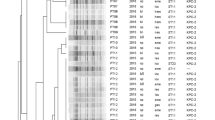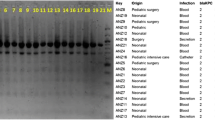Abstract
Background
Thus far, studies on Klebsiella pneumoniae carbapenemase (KPC)-producing organisms have only been reported in those with a history of foreign travel, and a specific Japanese KPC-producing isolate has not yet been reported.
Case presentation
We describe a Japanese patient, with no history of travel to foreign countries, admitted due to aspiration pneumonia, and a KPC-producing isolate detected in his sputum. Fortunately, his pneumonia resolved. His close contacts did not have a history of foreign travel, and the isolate was not detected in other patients.
Conclusions
The potential for KPC-producing organisms to become endemic in Japan is currently of great concern.
Similar content being viewed by others
Background
Klebsiella pneumoniae carbapenemase (KPC)-producing Enterobacteriaceae have been reported in many countries, and outbreaks due to KPC-producing organisms have been reported worldwide [1,2,3]. KPC is an enzyme that degrades penicillin, cephalosporin, and broad-spectrum β-lactams such as the carbapenems. This type of β-lactamase was discovered relatively recently, first detected in a strain isolated in the United States in 1996 [2]. The strain was considered a novel β-lactamase able to degrade carbapenem antibiotics; it was classified as a Bush group 2f, class A, serine-β-lactamase and was named KPC [4]. Because the mortality from infection by KPC-producing organisms is reportedly higher than that of non-KPC-producers, these isolates have received a great deal of attention worldwide [5]. The most common carbapenemase gene to be reported in Japan is the IMP-type metallo-β-lactamase encoding gene [6] and the most common types are blaIMP-1 and blaIMP-6. However, in Japan, KPC-producing organisms have so far only been reported as infections in patients who had visited foreign countries wherein KPC-producing organisms have been reported [7]. We report a Japanese patient without a history of travel to foreign countries whose sputum samples tested positive for a KPC producing isolate. The current report highlights a new concern regarding KPC-producing organisms that may already be present in Japan.
Case presentation
A man in his early 90s was undergoing a follow-up for mild idiopathic interstitial pneumonia. He required assistance to perform activities of daily living, spent most of the day at home, and received periodic home visits for medical care. His last hospitalization was in February 2016 for approximately 1 month due to aspiration pneumonia. Only oral commensal bacteria were cultured from his sputum during his last hospitalization. In July 2016, he was hospitalized again for aspiration pneumonia. The sputum smears obtained on the first day of admission showed the presence of polymicrobial, normal oral bacteria and polymorphonuclear leukocytes. Subsequent cultures from this sputum showed normal oral bacteria as well as a few K. pneumoniae, with high levels of resistance to all antimicrobial agents except for minocycline. Results of examination of blood culture obtained on admission were negative. Other cultures were not examined. The patient had no history of travel to other countries and had never left Japan. Ampicillin/sulbactam was started at the time of hospitalization. On the 4th day of hospitalization, the antimicrobial agent was changed to cefepime because the clinical course was exacerbated. After the 5th day, the patient’s clinical course improved, and this treatment was continued until the 12th day. The antimicrobial was not changed when K. pneumoniae was observed on a sputum culture collected on admission. The patient was discharged after his aspiration pneumonia had been successfully treated. Despite administering antibiotics that are generally not effective against K. pneumoniae, K. pneumoniae was not detected from his sputum after treatment.
Laboratory investigation
During laboratory investigation, we found that gram-negative bacillus grew on 5% sheep blood agar. Carbapenem-resistant K. pneumoniae was identified by Phoenix100 and NMIC/ID-208 panel (Becton, Dickinson and Company). Minimum inhibitory concentration of both meropenem and imipenem was > 8 μg/ml, and the sodium mercaptoacetate disk test result was negative. The modified Hodge test (using ertapenem disk) result was positive for K. pneumoniae TUM16641. The DNA of K. pneumoniae TUM16641 was sequenced using MiSeq (Illumina, Inc., CA, USA), and the DNA library for Illumia MiSeq sequencing was prepared using the Nextera XT Library Prep Kit (Illumina). The Nextera XT DNA library was sequenced in a paired-end 300 cycles mode on MiSeq using 600 cycles Reagent Kit v3 (Illumina). Draft genomes (contigs) were obtained using CLC Genomics Workbench (Qiagen). TUM16641 belonged to sequence type (ST) 258 analyzed by multilocus sequence typing. A carbapenemase gene, blaKPC-2, was detected in the contigs. To characterize a blaKPC-2 carrying plasmid, we used a long reads sequencing platform, MinION (Oxford Nanopore Technologies [ONT], Oxford Science Park, UK). A MinION library was prepared from K. pneumoniae TUM16641 genomic DNA using Ligation Sequencing Kit 1D (SQK-LSK108) and Native Barcoding Kit (EXP-NBD103) (ONT). The MinION DNA library was sequenced using Flow Cell R9.4 (FLOW-MIN106) (ONT). The complete plasmid sequence was obtained using SPAdes assemblers in combination with MiSeq and MinION data [8]. The sequencing data showed that the K. pneumoniae TUM16641 harbored a hybrid replicon of the IncX3 and IncU plasmid (pMTY16641_IncX3-IncU) carrying blaKPC-2 (Fig. 1). The nucleotide sequence of pMTY16641_IncX3-IncU plasmid (GenBank accession number BFCA01000004) highly resembled that of pKP13d, pKP1194a, and pKP64477d of K. pneumoniae obtained from different reports in Brazil (Fig. 1). K. pneumoniae TUM16641 also harbored two antibiotic resistance gene carrying plasmids, a hybrid replicon of IncFIB and IncFII plasmid (pMTY16641_IncFIB-IncFII) carrying aadA2, aph(3′)-Ia, mph(A), catA, sul1, and dfrA12 and a IncA/C2 plasmid (pMTY16641_IncA/C2) carrying aac(3′)-IId, rmtB, strA, strB, blaTEM-1B, blaCTX-M-14, sul2, tet(G) (Table 1).
Comparison of pMTY16641_IncX3_IncU (BFCA01000004) carrying blaKPC-2 with pKP13d (CP003997), pKP1194a (KX756453), and pKP64477d (MF150120) drawn with EasyFig 2.1. All four plasmids were hybrid replicons of IncX3 and IncU. Arrow size is proportional to the predicted ORF length. The color code is as follows: The antibiotic resistance genes are in black and conjugal transfer genes are in gray. Others, putative, hypothetical, and unknown genes are represented by white arrows. Abbreviations: ORF: Open Reading Frame
The GenBank accession number for the draft whole-genome sequence data of the K. pneumoniae TUM16641 is DRR076334.
Discussions and conclusions
To our knowledge, this case showed the first possibility of a new threat in Japan regarding a KPC-producing isolate not linked with a history of travelling to other countries. The KPC-producing isolate was not detected in any other patients in the hospital where this patient was hospitalized previously; thus, the transmission route of this strain remains unclear. However, the present case suggests that KPC-producing organisms may be prevalent in Japan. Although no environmental culture was performed, the same bacteria were not observed in general culture tests of other patients who were hospitalized in the same medical institution. The origin of this isolate was unclear. This isolate was similar to a type reported in Brazil (assigned to the GenBank nucleotide sequence database under the accession number KU963389.1) and the USA [9]. The reported risks for infection by KPC-producing bacteria include patient immunodeficiency, use of intravascular devices, and use of various antimicrobial agents [10, 11]. No intravascular devices and no agents that could lead to immunodeficiency were used in this patient. However, considering that he was elderly, had experienced aspiration pneumonia, and had undergone 10 days of antibiotic treatment 5 months previously, the KPC-producing organism identified in his sputum may have been selected by exposure to ampicillin/sulbactam and meropenem. This patient’s symptoms were relieved by treatment of his bacterial pneumonia. The patient was likely a carrier of a KPC-producing isolate, as he did not develop a K. pneumoniae infection. Clinical improvement without susceptible antimicrobial agents suggests the possibility that K. pneumoniae was not the causative organism in the present case.
We report a new public health concern in Japan regarding a KPC-producing isolate detected in a Japanese patient with no history of foreign travel. These findings highlight a growing concern regarding the potential spread of KPC-producing organisms, and that the possibility of detecting such bacteria should be considered even in Japan.
Abbreviations
- KPC:
-
Klebsiella pneumoniae carbapenemase
References
Naas T, Nordmann P, Vedel G, Poyart C. Plasmid-mediated carbapenem-hydrolyzing β-lactamase KPC in a Klebsiella pneumoniae isolate from France. Antimicrob Agents Chemother. 2005;49(10):4423–4.
Woodford N, Tierno PM Jr, Young K, Tysall L, Palepou MF, Ward E, et al. Outbreak of Klebsiella pneumoniae producing a new carbapenem-hydrolyzing class a beta-lactamase, KPC-3, in a New York medical center. Antimicrob Agents Chemother. 2004;48(12):4793–9.
Wei ZQ, Du XX, Yu YS, Shen P, Chen YG, Li LJ. Plasmid-mediated KPC-2 in a Klebsiella pneumoniae isolate from China. Antimicrob Agents Chemother. 2007;51(2):763–5.
Yigit H, Queenan AM, Anderson GJ, Domenech-Sanchez A, Biddle JW, Steward CD, et al. Novel carbapenem-hydrolyzing β-lactamase, KPC-1, from a carbapenem-resistant strain of Klebsiella pneumoniae. Antimicrob Agents Chemother. 2001;45(4):1151–61.
Marchaim D, Navon-Venezia S, Schwaber MJ, Carmeli Y. Isolation of imipenem-resistant Enterobacter species: emergence of KPC-2 carbapenemase, molecular characterization, epidemiology, and outcomes. Antimicrob Agents Chemother. 2008;52(4):1413–8.
Yano H, Ogawa M, Endo S, Kakuta R, Kanamori H, Inomata S, et al. High frequency of IMP-6 among clinical isolates of metallo-β-lactamase-producing Escherichia coli in Japan. Antimicrob Agents Chemother. 2012;56(8):4554–5.
Saito R, Takahashi R, Sawabe E, Koyano S, Takahashi Y, Shima M, et al. First report of KPC-2 carbapenemase-producing Klebsiella pneumoniae in Japan. Antimicrob Agents Chemother. 2014;58(5):2961–3.
Bankevich A, Nurk S, Antipov D, Gurevich AA, Dvorkin M, Kulikov AS, et al. J Comput Biol. 2012;19(5):455–77.
Ho PL, Cheung YY, Lo WU, Li Z, Chow KH, Lin CH, et al. Molecular characterization of an atypical IncX3 plasmid pKPC-NY79 carrying bla KPC-2 in a Klebsiella pneumoniae. Curr Microbiol. 2013;67(4):493–8.
Nordmann P, Cuzon G, Naas T. The real threat of Klebsiella pneumoniae carbapenemase-producing bacteria. Lancet Infect Dis. 2009;9(4):228–36.
Woodford N, Tierno PM Jr, Young K, Tysall L, Palepou MF, Ward E, et al. Outbreak of Klebsiella pneumoniae producing a new carbapenem-hydrolyzing class a β-lactamase, KPC-3, in a New York medical center. Antimicrob Agents Chemother. 2004;48(12):4793–9.
Acknowledgements
Not applicable.
Funding
There is no funding to declare in this study.
Availability of data and materials
The data that support the findings of this study are available from the corresponding author (YA) upon request.
Author information
Authors and Affiliations
Contributions
YA1 (corresponding author) was in charge of infection control and drafted the manuscript. KA and YI performed the whole-genome sequencing analysis of K. pneumoniae TUM16641 and helped with the draft of the manuscript. KO, HF and RM treated the patient. TS, FNU and HK also coordinated infection control. YA2, MF, HH and HA performed biochemical tests for this strain. KO revised the article for intellectual content. All authors have read and critically revised the first as well as the subsequent and final drafts of this manuscript. All authors read and approved the final manuscript.
Corresponding author
Ethics declarations
Ethics approval and consent to participate
The study was in accordance with the tenets of the Declaration of Helsinki. The requirement for approval from the Ethics Committee is unnecessary, based on the guidelines of the Ministry of Health, Labor and Welfare in Japan. The Ethics Committee at Tokyo Metropolitan Health and Medical Treatment Corporation Ebara Hospital ruled that no formal ethical approval was required for reporting this case.
Consent for publication
Written consent to publish the case report was obtained from the patient.
Competing interests
The authors declare that they have no competing interests.
Publisher’s Note
Springer Nature remains neutral with regard to jurisdictional claims in published maps and institutional affiliations.
Rights and permissions
Open Access This article is distributed under the terms of the Creative Commons Attribution 4.0 International License (http://creativecommons.org/licenses/by/4.0/), which permits unrestricted use, distribution, and reproduction in any medium, provided you give appropriate credit to the original author(s) and the source, provide a link to the Creative Commons license, and indicate if changes were made. The Creative Commons Public Domain Dedication waiver (http://creativecommons.org/publicdomain/zero/1.0/) applies to the data made available in this article, unless otherwise stated.
About this article
Cite this article
Ainoda, Y., Aoki, K., Ishii, Y. et al. Klebsiella pneumoniae carbapenemase (KPC)-producing Klebsiella pneumoniae ST258 isolated from a Japanese patient without a history of foreign travel - a new public health concern in Japan: a case report. BMC Infect Dis 19, 20 (2019). https://doi.org/10.1186/s12879-018-3649-9
Received:
Accepted:
Published:
DOI: https://doi.org/10.1186/s12879-018-3649-9





